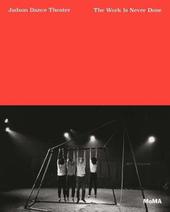
|
Judson Dance Theater: The Work is Never Done
Paperback / softback
Main Details
| Title |
Judson Dance Theater: The Work is Never Done
|
| Authors and Contributors |
By (author) Ana Janevski
|
|
By (author) Thomas J. Lax
|
| Physical Properties |
| Format:Paperback / softback | | Pages:200 | | Dimensions(mm): Height 255,Width 202 |
|
| Category/Genre | Contemporary dance |
|---|
| ISBN/Barcode |
9781633450639
|
| Audience | |
|---|
| Illustrations |
Illustrated in colour and black and white throughout
|
|
Publishing Details |
| Publisher |
Museum of Modern Art
|
| Imprint |
Museum of Modern Art
|
| Publication Date |
6 September 2018 |
| Publication Country |
United States
|
Description
An exploration of Judson Dance Theater's radical influence on postwar American art history and its lasting impact on contemporary artistic discourse. Taking its name from the Judson Memorial Church, a socially engaged Protestant congregation in New York's Greenwich Village, Judson Dance Theater was organized as a series of open workshops from which its participants developed performances. Redefining the kinds of movement that could count as dance, the Judson participants - Trisha Brown, Lucinda Childs, Philip Corner, Bill Dixon, Judith Dunn, David Gordon, Alex Hay, Deborah Hay, Fred Herko, Robert Morris, Steve Paxton, Rudy Perez, Yvonne Rainer, Robert Rauschenberg, Carolee Schneemann and Elaine Summers, among others - would go on to profoundly shape all fields of art in the second half of the 20th century. Judson Dance Theater: The Work Is Never Done highlights the ongoing significance of the history of Judson Dance Theater. Published in conjunction with an exhibition at The Museum of Modern Art, it charts the development of Judson, beginning with the workshops and classes led by Anna Halprin, Robert Ellis Dunn and James Waring, and exploring the influence of other figures working downtown such as Simone Forti and Andy Warhol, as well as venues for collective action like Judson Gallery and the Living Theatre. Lushly illustrated with film stills, photographic documentation, reproductions of sculptural objects, scores, music, poetry, architectural drawings and archival material, the publication celebrates the group's multidisciplinary and collaborative ethos as well as the range of its participants.
Author Biography
Ana Janevski is Curator in the Department of Media and Performance Art at the Museum of Modern Art. Thomas J. Lax is Associate Curator of Media and Performance Art at MoMA, a position he's held since 2014.
Reviews...revolutionized dance and performance.--Gia Kourlas "New York Times" A different level of recognition, and an introduction to a wider public.--Brian Seibert "New Yorker" Both the exhibition and the book compose a portrait of a place and time from the scattershot shards the artists left behind.--Jennifer Krasinski "Bookforum" Documents their boundary-breaking work, with archival footage of past performances on hand to add context, as well as props originally used in these works.-- "Art News" Gorgeously heterogeneous, Judson, when given the opportunity, reveals exceptions to every rule.--Catherine Damman "Artforum" I am so grateful to this exhibition for reminding us how radical it was for the artists associated with Judson Dance Theater to focus on quotidian gestures and temporalities- and for proving just how grand the movements of daily life continue to be.-- "Artforum" Judson Dance Theatre legitimized ordinary movement as a dance movement.-- "New Yorker" Looks at how the theater challenged traditional ideas of choreography, stripping dance of its theatrical conventions, employing ordinary movements such as gestures used at home or on the streets and made-up games.--Sahar Khan "Modern Luxury Manhattan" There are young and youngish choreographers today who seem inhibited by the Judson legacy, eager to keep earning their Judson qualifications.--Alastair Macaulay "New York Times" Through archival materials, film screenings, discussions and live performance, the show explores the history and impact of Judson Dance Theater.--Siobhan Burke "New York Times" Using primary source reproductions as front matter prepares readers for the catalogue's heavily archival contents, but above all points to how such material is paramount to piecing together Judson's history.--Nicole Meily "Brooklyn Rail"
|